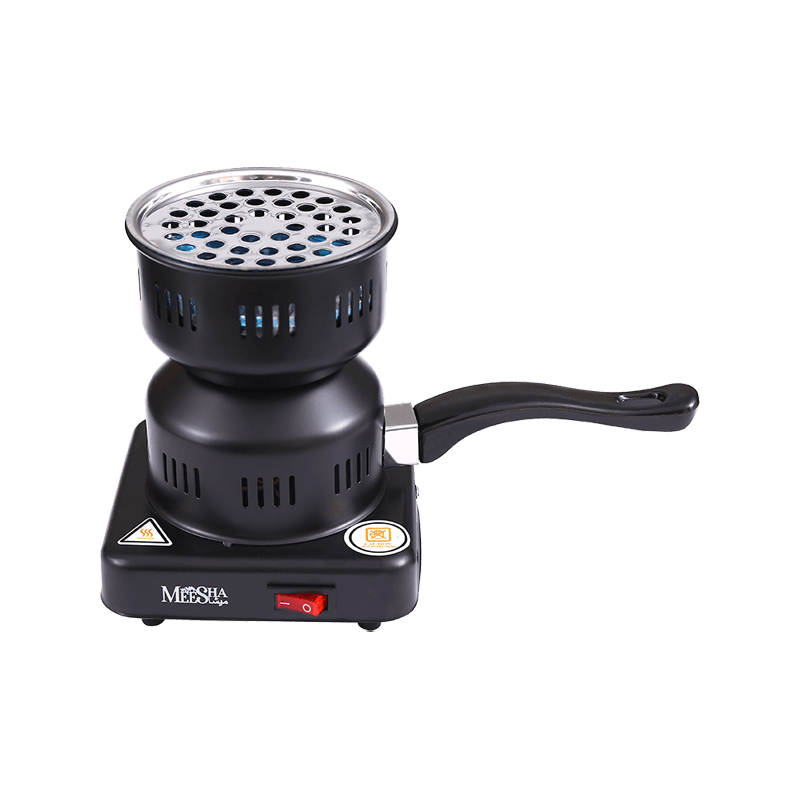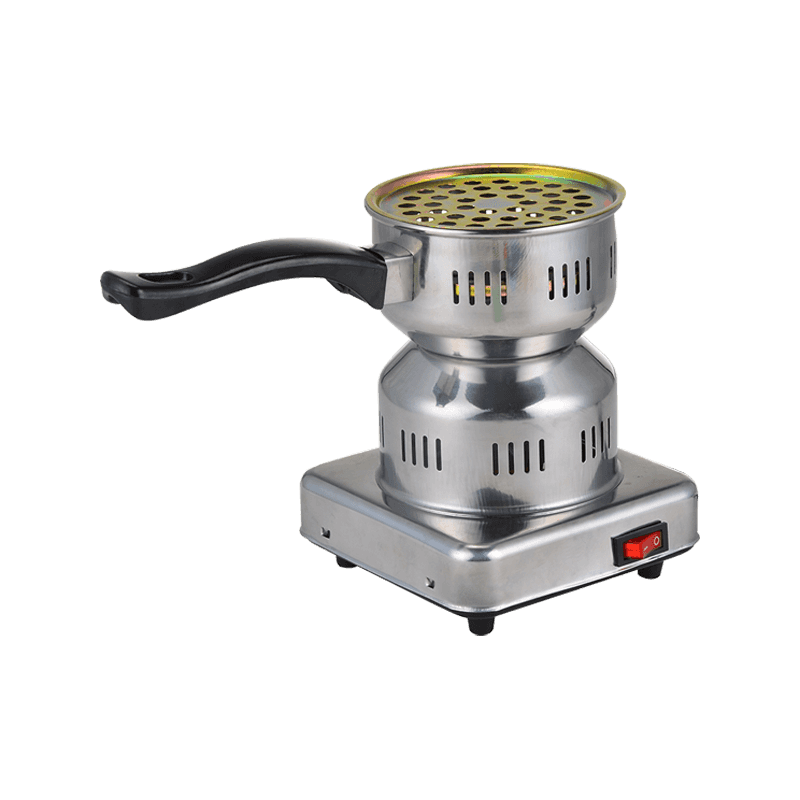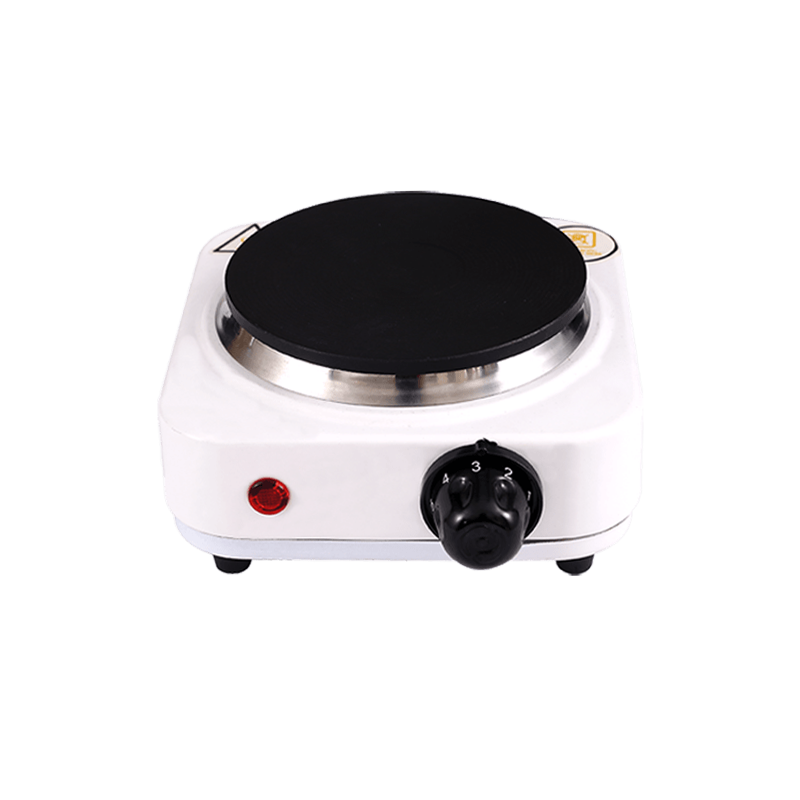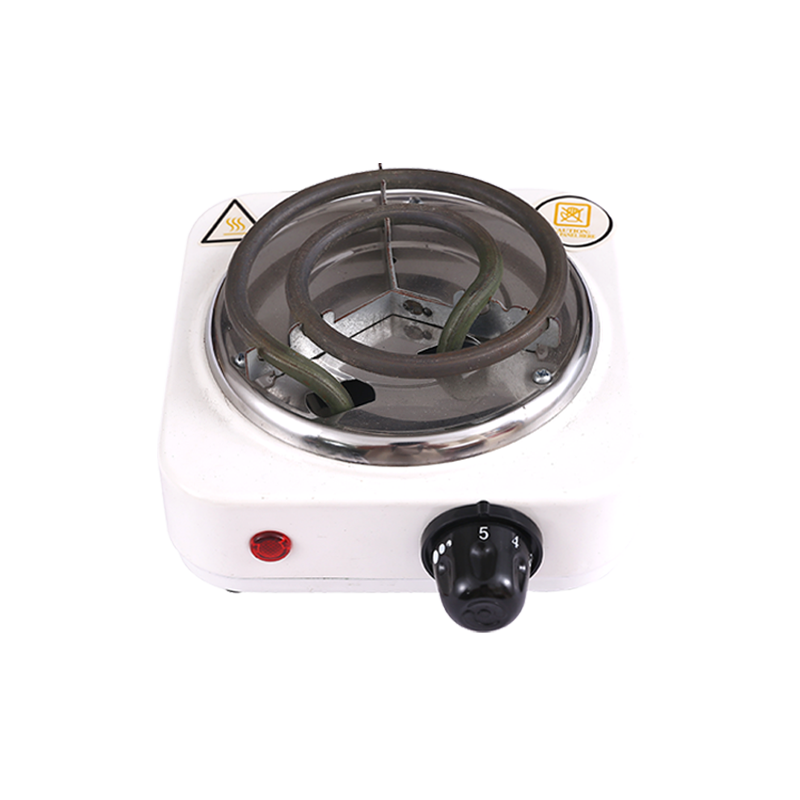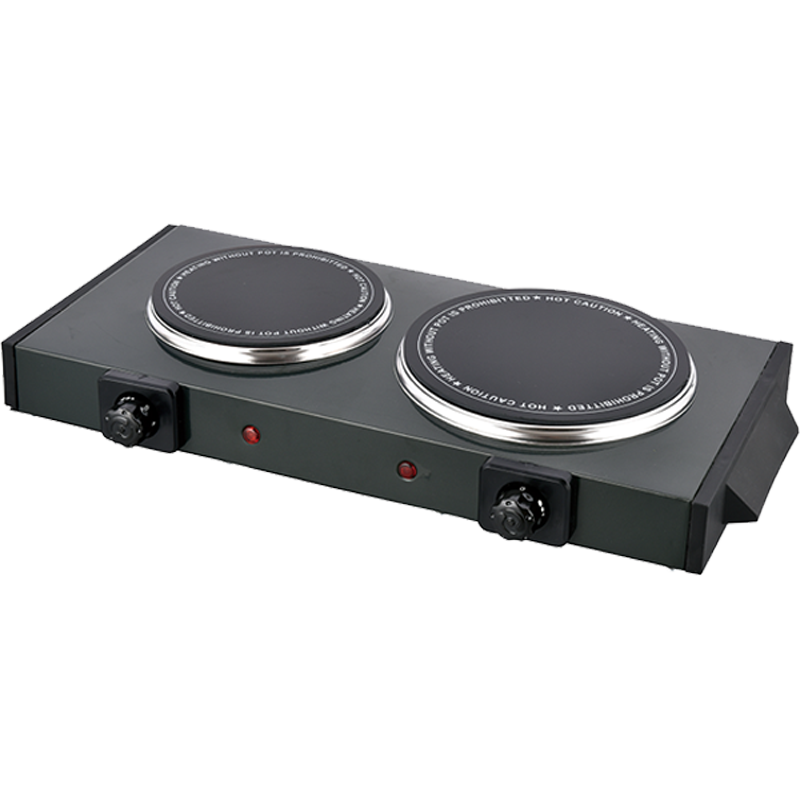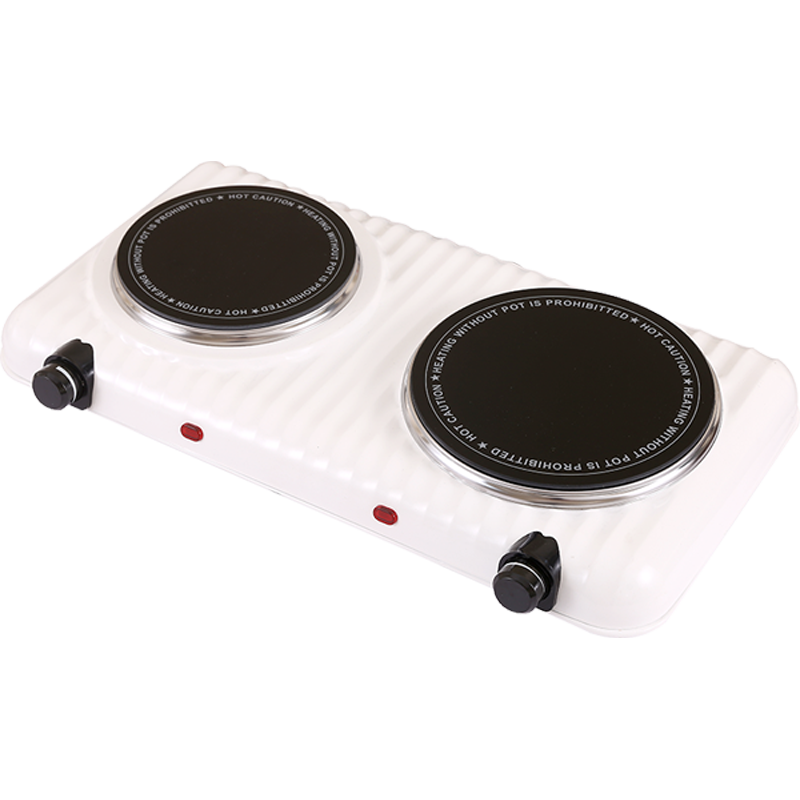+86-579-87253168
What is an Electric Hot Plate Burner?
An electric hot plate burner is a portable, compact appliance designed to heat cookware for cooking or warming food. It operates by generating heat through electrical resistance, making it a versatile option for those who need additional cooking surfaces in small kitchens, dorm rooms, or offices. Typically, these devices come with one or two heating elements, and they are powered by electricity, which makes them a convenient alternative to gas stoves or larger cooktops.
Electric hot plates have been popular for their convenience and efficiency, providing an instant heat source for cooking tasks. They are available in various sizes and designs, making them suitable for a range of cooking needs, from boiling water to frying or simmering dishes. Whether used in households or commercial kitchens, electric hot plates offer an efficient way to prepare meals without requiring extensive space or complicated installation.
Key Features to Look for in an Electric Hot Plate Burner
When choosing an electric hot plate burner, it is important to understand the key features that contribute to its performance, durability, and ease of use. Below are the top considerations to keep in mind when selecting the ideal model for your needs:
1. Temperature Control
One of the most important features of an electric hot plate burner is its ability to control the temperature. Look for a unit that offers precise and adjustable temperature settings. Models with a thermostat or a dial control allow for fine-tuned temperature adjustments, which is crucial for tasks such as simmering, frying, or boiling. Some units feature multiple heat settings for different cooking needs, making them more versatile.
For enhanced convenience, certain advanced models may even include digital controls that allow for more accurate temperature settings, helping you avoid overheating or undercooking your food.
2. Size and Portability
Portability is one of the defining characteristics of electric hot plates. These appliances are generally lightweight and easy to move, making them perfect for small kitchens, RVs, offices, or camping trips. When selecting a hot plate, consider the size and the number of burners.
Single vs. Double Burners: Single-burner units are typically more compact and can be an excellent option for people with limited space. However, if you need to prepare multiple dishes at once, a double-burner hot plate offers more cooking flexibility, allowing you to cook two dishes simultaneously.
The size of the heating element is also important. Larger elements may provide faster heating and accommodate bigger pans, but they may also take up more space and consume more energy.
3. Material and Durability
The materials used in the construction of an electric hot plate burner play a significant role in its durability and performance. Common materials for the cooking surface include:
Coil: These traditional burners are durable and easy to clean but may heat unevenly compared to other types.
Ceramic: Known for even heat distribution, ceramic burners are more modern and visually appealing. They are also easier to clean, as food is less likely to get stuck on the surface.
Induction: Induction hot plates provide rapid heating and energy efficiency by using magnetic fields. However, they require compatible cookware (magnetic base) to work properly.
Choosing a burner with a sturdy stainless steel base or cast iron body enhances durability, as these materials can withstand high temperatures and resist rust.
4. Safety Features
Safety should be a priority when selecting an electric hot plate burner, especially if it will be used by children, elderly individuals, or in environments where safety is a concern. Look for features such as:
Overheat Protection: Some models come with automatic shut-off mechanisms if the unit gets too hot, preventing potential fire hazards.
Non-slip Feet: A stable, non-slip base ensures the hot plate stays securely in place, reducing the risk of accidents during use.
Cool-touch Exteriors: Some modern hot plates are designed with cool-touch technology that minimizes the risk of burns when the unit is in use.
5. Energy Efficiency
Electric hot plates are generally more energy-efficient than gas stoves. However, their energy consumption can vary depending on the heating method used and the unit's size. When shopping for an electric hot plate burner, check for energy-efficient models that can save you money on electricity bills in the long run.
Induction Heating: Induction models are particularly energy-efficient, as they heat pots and pans directly without wasting energy in the surrounding air.
Coil Heating: Coil models tend to take longer to heat up and may lose more heat, making them less energy-efficient than newer technologies.
Choosing a model with energy-efficient features, such as automatic power-off when the plate is idle, can help minimize energy waste.
6. Ease of Cleaning
Ease of cleaning is an important consideration, especially for those who use the hot plate frequently. Choose a model with a non-stick surface or smooth ceramic top for easier cleanup. A coil-style hot plate may require more effort to clean, as food can get stuck in the coils.
Some models also have removable drip trays or removable heating elements that make maintenance more convenient. Regular cleaning of the heating surface and the base will not only keep the appliance looking good but also extend its lifespan.
7. Warranty and Customer Support
Investing in an electric hot plate burner is a long-term commitment, so it's essential to choose a model that comes with a warranty for added peace of mind. The warranty can protect you against any defects or malfunctions in the product. Additionally, look for brands that offer strong customer support, ensuring that any issues you encounter are resolved quickly and efficiently.
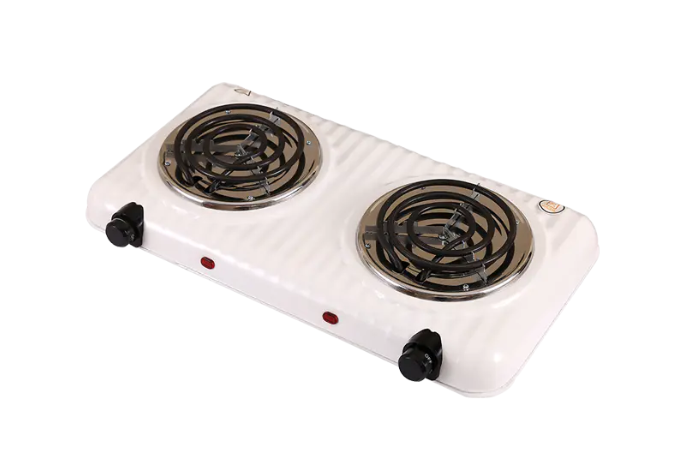
Applications of Electric Hot Plate Burners
1. Home Cooking and Small Kitchens
In households, electric hot plate burners are ideal for individuals living in smaller spaces such as apartments, dormitories, or studio apartments. For those who lack a full-sized stove, they provide a portable solution for everyday cooking. Whether boiling, frying, or simmering, these compact units offer a quick and efficient way to prepare meals without taking up much counter space.
Convenience for Busy Lifestyles: For individuals who live in shared apartments or those who have limited cooking space, a portable electric burner can be a convenient option. It's also an ideal choice for students in dorms who may not have access to a full kitchen.
Cooking in Tight Spaces: Small kitchens or vacation homes often lack sufficient cooking surfaces. In these scenarios, a hot plate can supplement the primary cooking equipment, allowing users to prepare multiple dishes at once.
2. Commercial Kitchens and Food Trucks
Electric hot plate burners are widely used in commercial settings such as food trucks, small restaurants, or catering services. These units provide a reliable, portable heat source that can be used to cook food in tight spaces or temporary setups.
Food Trucks and Street Food Vendors: In food trucks, space and mobility are critical. An electric burner is a compact, energy-efficient tool that can be easily stored and used to prepare dishes like pancakes, stir-fries, or grilled sandwiches.
Catering and Pop-up Events: For catering services or pop-up restaurants that need to quickly set up cooking stations, a hot plate burner offers a portable and flexible option to cook a variety of foods without the need for a full kitchen setup.
3. Laboratories and Industrial Use
Apart from culinary applications, electric hot plate burners are also employed in laboratories and industrial settings where precise heating is required. These burners are especially useful for tasks such as heating chemicals or conducting experiments that need controlled temperature environments.
Laboratories: In chemistry labs, hot plate burners are often used to heat liquids in beakers or flasks. Their ability to provide stable heat is crucial for conducting accurate experiments without the risk of open flames.
Industrial Applications: In industries such as pharmaceutical or food production, electric hot plates may be used for tasks like melting materials or sterilizing equipment. They offer a safer and cleaner alternative to traditional heating methods like gas burners.
4. Outdoor and Camping Activities
For camping enthusiasts, outdoor cooking, and survival situations, electric hot plate burners provide a convenient cooking solution. With the help of portable power sources such as generators or solar-powered setups, these burners can be used outdoors to cook meals in remote locations.
Portable Cooking: Many outdoor enthusiasts opt for electric burners due to their ease of use. Whether camping, tailgating, or traveling in RVs, a portable electric burner ensures that you have a reliable cooking source while minimizing the need for bulky stoves or gas canisters.
5. Emergency Backup in Case of Power Outages
Electric hot plates can also serve as an emergency backup during power outages. In case your stove or oven becomes inoperable, an electric hot plate burner can continue to function as a reliable cooking option, especially when you need to prepare a meal quickly during an emergency situation.
How Electric Hot Plate Burners Work
The basic function of an electric hot plate burner is relatively simple, but the underlying technology varies depending on the type of burner. Let's break down how these devices work and the different methods of heating used in their design.
1. Basic Functionality of Electric Heating Elements
Electric hot plate burners operate through a process of electrical resistance heating. When current flows through the heating element, it encounters resistance, which results in the conversion of electrical energy into heat. This heat is then transferred to the cooking surface and, ultimately, to the cookware placed on top of the burner.
Heating Element: In most electric burners, the heating element is typically made of materials like nickel-chromium (NiCr) or other metals that can withstand high temperatures. As electricity passes through these materials, they heat up and radiate energy.
Heat Transfer: The heat generated by the element is transferred directly to the cookware, which in turn cooks the food. This transfer of heat is more efficient in certain types of heating elements than others.
2. Types of Electric Heating Methods
Electric hot plates are available with different types of heating elements, each offering distinct advantages in terms of efficiency, speed, and even heat distribution.
Coil Heating Elements: The traditional design of electric hot plates includes coil elements made of metal wire that heats up when electricity passes through. These coils can reach high temperatures quickly but may have uneven heat distribution. While they are affordable and reliable, they tend to be less energy-efficient compared to newer designs.
Ceramic Heating Elements: Ceramic burners use an insulated ceramic plate that heats up evenly and is more energy-efficient than coil elements. Ceramic surfaces allow for smoother, even heating, making them suitable for cooking tasks that require consistent temperature control.
Induction Heating: Induction hot plates use electromagnetic fields to directly heat the cookware. Unlike traditional resistance heating, which heats the cooking surface, induction burners heat the pot itself. This method is highly efficient, as it generates less heat waste and is quicker compared to coil and ceramic models. However, induction heating requires compatible cookware with a ferrous base (magnetic cookware).
3. Temperature Control Mechanisms
Electric hot plate burners typically offer one or more methods for controlling heat. The most common options include:
Dial or Knob Control: Most electric burners have a manual dial or knob that adjusts the temperature by controlling the power supply to the heating element. These controls usually offer a range of settings from low to high, providing a simple way to manage cooking temperatures.
Digital Control: Advanced models may feature digital controls with precise temperature settings. These systems often include LED displays and touchscreens, allowing for better accuracy and ease of use when adjusting the heat.
Thermostat-Controlled Models: Some units are equipped with a built-in thermostat that maintains a constant temperature by automatically adjusting the heat as necessary. This feature is particularly beneficial for slow cooking or simmering.
4. Safety and Overheat Protection
Many modern electric hot plate burners come with built-in safety features, such as overheat protection and automatic shut-off. These mechanisms prevent the burner from reaching dangerously high temperatures, helping to avoid accidents. Overheat protection works by automatically cutting off power when the unit detects excessive heat, providing added peace of mind.
Types of Electric Hot Plate Burners
1. Coil Electric Hot Plate Burners
Coil burners are the most traditional type of electric hot plates and are often the most affordable. They are widely used due to their durability and simplicity. A coil burner typically features a metal coil that heats up when electricity flows through it, creating heat that is transferred to the cookware.
Key Features and Benefits
Durability: Coil burners are built to last. The metal coils are sturdy and resistant to wear and tear, making them ideal for long-term use.
Cost-Effective: These burners are generally more affordable compared to other types, making them a popular choice for those on a budget.
Even Heat Distribution: While coil burners can provide even heat across the cooking surface, the heat distribution can sometimes be inconsistent, leading to hot spots on the cookware.
Versatile Compatibility: Coil burners work with most types of cookware, making them flexible for everyday use.
Ideal Use
Coil burners are perfect for home cooking and small kitchens where budget and reliability are key. They are also well-suited for temporary cooking setups, such as for dorm rooms, camping, or small apartments.
2. Ceramic Electric Hot Plate Burners
Ceramic burners represent a modern upgrade from coil-based models. They feature a smooth, flat ceramic surface that evenly distributes heat. Ceramic hot plates are commonly found in newer designs, offering better heat control and aesthetic appeal.
Key Features and Benefits
Even Heat Distribution: One of the major advantages of ceramic burners is their ability to distribute heat uniformly. The flat ceramic surface ensures consistent cooking, reducing the likelihood of hot spots.
Sleek Design: Ceramic burners have a modern, sleek appearance that is easy to clean. The smooth surface also prevents food from getting stuck, making cleanup a breeze.
Energy Efficiency: These units tend to be more energy-efficient than coil burners, as they require less power to reach the desired temperature.
Temperature Control: Ceramic burners often come with precise temperature settings and adjustable controls, allowing for better control over cooking processes like simmering, boiling, or frying.
Ideal Use
Ceramic electric hot plate burners are best for individuals seeking aesthetic appeal, easy cleaning, and consistent heat control. They work well in home kitchens or even commercial kitchens where cooking quality is a priority.
3. Induction Electric Hot Plate Burners
Induction burners are the most advanced type of electric hot plates, using magnetic fields to directly heat cookware rather than heating the burner surface itself. This method is extremely energy-efficient, as the heat is generated directly in the cookware, reducing heat loss to the surrounding air.
Key Features and Benefits
High Efficiency: Induction burners offer unparalleled energy efficiency. Since they heat the cookware directly, there is minimal heat loss, and the cooking process is faster than with traditional electric hot plates.
Precision Heating: Induction burners allow for extremely precise temperature control, making them perfect for delicate cooking tasks. Many models have adjustable power settings that let you customize the temperature down to the degree.
Safe and Cool-to-Touch: Induction burners are safe to use because the surface remains cool to the touch during operation. Only the cookware gets hot, reducing the risk of burns.
Compatibility with Cookware: Induction cooking requires ferrous (magnetic) cookware, such as cast iron or stainless steel. Cookware made of aluminum or glass will not work on an induction burner.
Easy to Clean: The smooth surface of induction burners makes them easy to clean, as food doesn’t burn onto the surface, and any spills are easy to wipe off.
Ideal Use
Induction electric hot plate burners are perfect for energy-conscious consumers and those who require high-efficiency cooking. They are ideal for modern homes, commercial kitchens, and professional chefs who need precision in their cooking. They are also well-suited for small apartments where space is limited but cooking quality is paramount.

Single vs. Double Burners: Choosing the Right Setup for Your Needs
When it comes to electric hot plate burners, one of the first decisions you’ll face is whether to opt for a single burner or a double burner model. Both have their advantages depending on your cooking needs, available space, and desired cooking efficiency. Let’s explore the differences between the two options and the factors to consider when making your choice.
Single Burners: Compact and Portable
A single burner electric hot plate is the most compact type, ideal for individuals with limited kitchen space or those who need a portable cooking solution. These units typically feature one heating element and are designed for simplicity and efficiency.
Key Advantages of Single Burners:
Space-Saving: Single burners are compact and take up very little counter space, making them perfect for small kitchens, dorm rooms, or as a backup cooking appliance.
Portability: Due to their lightweight design, single burners are easy to transport, making them a great option for outdoor cooking, camping trips, or temporary setups.
Lower Cost: Single burner models are often more affordable than double burners, which makes them a great choice for those on a budget.
Ideal Use Cases for Single Burners:
Small Kitchens: In apartments or homes with limited counter space, a single burner offers an efficient cooking solution without the need for a full stove.
Supplementary Cooking: Single burners are ideal for quick, supplementary cooking tasks when you need additional cooking space but don’t want to invest in a larger unit.
Double Burners: Versatile and Efficient
A double burner hot plate features two heating elements, allowing you to cook multiple dishes simultaneously. This setup is ideal for users who require more cooking space or need to prepare complex meals with multiple ingredients.
Key Advantages of Double Burners:
Multiple Cooking Surfaces: Double burners provide the ability to cook two different dishes at once, making meal preparation faster and more efficient.
Time-Saving: If you're cooking for a family or need to prepare several components of a meal simultaneously, the extra burner allows for significant time savings.
Ideal for Larger Meals: Double burners are excellent for preparing larger meals or cooking for multiple people, as they provide more cooking flexibility.
Ideal Use Cases for Double Burners:
Families or Large Households: If you cook frequently for more than one person, a double burner provides the convenience of cooking multiple items at the same time.
Commercial Use: Small food trucks, catering services, or temporary setups benefit from the extra burner space, enabling multiple dishes to be prepared concurrently.
Coil vs. Ceramic vs. Induction Heating Elements: Understanding the Different Heating Technologies
The heating element in an electric hot plate burner determines how efficiently and evenly heat is distributed to your cookware. There are three main types of heating elements used in electric hot plate burners: coil, ceramic, and induction. Each technology offers distinct advantages and is suited to different cooking preferences and requirements.
Coil Heating Elements: Traditional and Durable
The coil heating element is the most traditional design used in electric hot plate burners. It consists of a metal coil, often made from nickel-chromium alloy, that heats up when electrical current flows through it. The coil is located on top of a flat metal base or within a protective casing.
Key Advantages of Coil Elements:
Durability: Coil elements are known for their robustness and longevity. They can withstand high temperatures and are less prone to wear and tear compared to other types of heating elements.
Affordability: Coil burners are typically more affordable than ceramic or induction models, making them a budget-friendly option for many users.
Versatility: Coil burners can be used with most types of cookware, including aluminum, stainless steel, and cast iron.
Ideal Use Cases for Coil Elements:
Basic Cooking Needs: Coil burners are best for individuals looking for a reliable, no-frills cooking option for everyday use.
Budget-Friendly Solutions: These units are perfect for those on a budget, offering an efficient cooking solution at a lower price point.
Ceramic Heating Elements: Modern and Efficient
Ceramic heating elements feature a flat ceramic surface that heats up quickly and evenly. Unlike coil burners, ceramic elements provide a smooth cooking surface that is easier to clean and provides more uniform heat distribution.
Key Advantages of Ceramic Elements:
Even Heat Distribution: Ceramic burners are known for their consistent and even heat distribution, which allows for more precise cooking and better food quality.
Ease of Cleaning: The smooth surface of ceramic elements makes cleaning easier, as food is less likely to stick and burn on the surface.
Aesthetic Appeal: Ceramic hot plates tend to have a modern, sleek appearance, which may be more visually appealing than traditional coil burners.
Ideal Use Cases for Ceramic Elements:
Home Kitchens: Ceramic burners are a great choice for home kitchens where both aesthetics and functionality are important. They provide a modern design while ensuring an efficient cooking experience.
Efficiency-Conscious Cooks: If you value energy efficiency and evenly distributed heat, ceramic models are a great choice.
Induction Heating Elements: High Efficiency and Precision
Induction heating is the most advanced technology used in electric hot plate burners. Instead of directly heating the burner surface, induction uses electromagnetic fields to heat the cookware directly. This results in faster cooking times and more energy-efficient heating.
Key Advantages of Induction Elements:
Energy Efficiency: Induction heating is much more energy-efficient than coil or ceramic heating, as it directly heats the cookware without wasting energy in the surrounding air.
Precise Temperature Control: Induction hot plates allow for precise and rapid temperature adjustments, making them ideal for delicate cooking tasks or when you need to maintain a consistent heat.
Cool-to-Touch Surface: Since the heating process is confined to the cookware, the surface of the induction burner remains cool to the touch, making it safer to use.
Quick Heating: Induction burners heat up incredibly fast, reducing cooking times and improving overall efficiency.
Ideal Use Cases for Induction Elements:
Modern Kitchens: Induction hot plates are perfect for contemporary homes and kitchens where energy efficiency, safety, and precision are top priorities.
Professional Chefs and Precise Cooking: Induction burners are ideal for chefs and cooking enthusiasts who require quick, efficient, and precise cooking.
Energy-Conscious Users: For those looking to reduce energy consumption while cooking, induction provides the most efficient heating method available.
Comparison: Coil, Ceramic, and Induction Heating Elements
| Feature | Coil Heating | Ceramic Heating | Induction Heating |
|---|---|---|---|
| Heating Speed | Slower | Moderate | Fastest |
| Heat Distribution | Uneven | Even | Very Even and Precise |
| Energy Efficiency | Low | Moderate | High |
| Ease of Cleaning | Requires more effort | Easy to clean | Easy to clean |
| Safety | Moderate | Moderate | High (cool-to-touch surface) |
| Price | Affordable | Mid-range | Expensive |
| Cookware Compatibility | Works with most cookware | Works with most cookware | Requires magnetic cookware |
Pros and Cons of Electric Hot Plate Burners
Pros of Electric Hot Plate Burners
Portability and Convenience
One of the main advantages of electric hot plate burners is their portability. These compact appliances are lightweight, easy to transport, and do not require installation. This makes them a perfect option for small kitchens, dormitories, vacation homes, or temporary setups. They can be easily moved from one location to another, offering flexibility in where and when you cook.
Space-Saving
Electric hot plate burners are ideal for small spaces. Whether you're living in a tiny apartment, a dorm, or even an RV, these burners take up much less space than traditional stoves or cooktops. This makes them a great choice for people who need to maximize their kitchen or living space without sacrificing their ability to cook efficiently.
Ease of Use
These units are generally easy to operate. Most electric hot plate burners feature simple temperature controls such as dials or knobs that allow users to adjust the heat quickly and easily. The learning curve is minimal, making them an ideal choice for individuals who need a quick and hassle-free cooking solution.
Energy Efficiency
Compared to gas stoves, electric hot plates are generally more energy-efficient. They use electricity to generate heat directly, which is more efficient than gas burners, where some energy is lost in the form of heat to the surrounding air. Modern induction burners, in particular, offer the highest level of energy efficiency by directly heating the cookware, which reduces energy waste.
Safety Features
Many electric hot plates are equipped with built-in safety features, such as overheat protection and auto-shutoff functions. These features ensure that the burner turns off when it gets too hot or when it has been left on for an extended period. This provides peace of mind, especially for households with children or elderly members.
Versatility in Cooking
Electric hot plate burners are versatile and can be used for various cooking tasks, from boiling water to frying, simmering, and even grilling, depending on the type of burner and cookware used. This makes them suitable for a wide range of recipes and cooking techniques.
Affordability
Electric hot plates are often more affordable than traditional stoves or induction cooktops. This makes them an attractive option for individuals on a budget or those who don't want to make a significant investment in kitchen equipment.
Cons of Electric Hot Plate Burners
Slower Heating Times (for Non-Induction Models)
One of the drawbacks of electric hot plate burners, especially coil burners, is that they can have slower heating times compared to gas stoves or induction burners. Coil elements take longer to heat up and cool down, which can make cooking slower. For ceramic and induction hot plates, the heating time is faster, but coil models still tend to lag in efficiency.
Limited Cooking Power
Electric hot plates generally have lower cooking power compared to gas stoves or high-end cooktops. This can be an issue for certain cooking tasks that require high heat, such as searing meat or stir-frying. The limited wattage of most burners means that cooking large quantities of food or dishes that require intense heat may take longer.
Incompatibility with Some Cookware
Induction hot plate burners require cookware that is magnetic (e.g., cast iron, stainless steel). If you don't have induction-compatible pots or pans, you will not be able to use an induction burner. While coil and ceramic models work with almost all types of cookware, this limitation is something to consider if you're planning to use induction cookers.
Less Control Over Heat Distribution (Coil Burners)
While coil burners are durable and affordable, they often suffer from uneven heat distribution. The metal coils do not always heat uniformly, which can lead to hot spots on the cookware, affecting cooking quality. Ceramic and induction models typically provide more even heat distribution, making them a better option for precision cooking.
Surface Can Get Hot and Be Difficult to Clean
On coil burners, the heating element itself can become very hot and may take longer to cool down after use, creating a potential risk for burns if not handled carefully. Additionally, food splatters can get stuck in the coils, requiring more effort to clean. While ceramic and induction burners are easier to clean, the surface of a hot coil burner can become dirty over time, particularly if spills are not cleaned immediately.
Limited Cooking Space
While double burner models address some of this issue, the cooking space on most electric hot plate burners is still limited compared to full-sized stoves. For large families or anyone who frequently cooks multiple dishes at once, electric hot plates might not provide enough cooking space.
Noise (for Some Models)
Certain models, particularly induction burners, can produce a faint buzzing or humming noise while in use due to the electromagnetic field generated during cooking. Although the noise is usually minimal, it can be bothersome for some users, especially in quiet environments.
| Pros | Cons |
|---|---|
| Portability and Convenience: Compact and easy to move, perfect for small spaces and temporary setups. | Slower Heating Times (for Non-Induction Models): Coil burners take longer to heat up and cool down compared to other types. |
| Space-Saving: Ideal for small kitchens, dorms, RVs, or as a secondary cooking appliance. | Limited Cooking Power: Generally less powerful than gas stoves, which may lead to slower cooking times for large or high-heat meals. |
| Ease of Use: Simple temperature controls, making them user-friendly for all levels of cooking expertise. | Incompatibility with Some Cookware (Induction Models): Induction burners require magnetic cookware, limiting options. |
| Energy Efficiency: Generally more energy-efficient than gas stoves, especially with induction heating. | Less Control Over Heat Distribution (Coil Burners): Coil models can heat unevenly, causing hot spots on cookware. |
| Safety Features: Many models come with overheat protection and automatic shut-off features. | Surface Can Get Hot and Be Difficult to Clean: Coil burners take time to cool down, and spills can be difficult to clean. |
| Versatility in Cooking: Can be used for various cooking methods such as boiling, frying, simmering, and more. | Limited Cooking Space: Most models provide limited cooking space, which can be a disadvantage for large meals. |
| Affordability: Generally more budget-friendly than full-sized stoves or other cooktops. | Noise (for Some Models): Induction models can create a faint buzzing or humming sound due to electromagnetic fields. |
How to Maintain and Clean Electric Hot Plate Burners
Proper maintenance and cleaning of your electric hot plate burner not only ensures its longevity but also guarantees efficient performance. Regular upkeep will keep the appliance functioning optimally, reduce the buildup of grime, and prevent potential hazards like overheating or electrical malfunctions.
General Maintenance Tips for Electric Hot Plate Burners
Regular Inspection
Conduct routine checks on your electric hot plate burner to identify any potential issues early. Look for visible signs of wear, such as cracked surfaces on ceramic or induction models, or damaged coils. If any issues are noticed, it's advisable to get them fixed before continuing to use the unit to avoid further damage.
Ensure Proper Ventilation
Electric hot plates, particularly coil and ceramic models, need adequate ventilation to avoid overheating. Keep the burner area clean and free of obstructions, such as paper towels, cloths, or other items, that might block the air vents and hinder heat dissipation.
Keep Power Cords Untangled and Secure
Ensure that the power cord is not frayed or exposed to moisture, as this can pose a safety hazard. Store the cord in a way that prevents tangling and damage, and always unplug the hot plate after use.
Avoid High-Temperature Settings
While electric hot plate burners are designed to withstand high heat, it's best to avoid running the unit at the maximum temperature settings for prolonged periods. Consistently using the appliance at high heat may lead to faster wear and potential damage to the heating element or surface.
Check for Overheating Indicators
Many modern electric hot plate burners come equipped with overheat protection systems. If the unit feels excessively hot or if it shuts off unexpectedly, this could indicate that the heating element or internal components are getting too hot. Allow it to cool down and reset before using it again.
Cleaning Coil Electric Hot Plate Burners
Coil burners tend to accumulate food particles and grease over time, especially when cooking at high temperatures. Regular cleaning is essential to maintain efficiency and prevent the buildup of harmful residue.
Unplug and Cool Down
Always unplug the appliance and allow the coils to cool down before cleaning. This ensures safety and prevents burns or electrical hazards.
Wipe Down with a Damp Cloth
For everyday cleaning, use a damp cloth or sponge to wipe down the coils. Avoid soaking the coils in water, as this could damage the electrical components.
Remove Stubborn Food Residue
For more stubborn residue, use a mild abrasive cleaner or baking soda paste (mix baking soda with water) to gently scrub the coils. Apply the paste to the dirty areas, let it sit for a few minutes, and then scrub with a soft sponge or brush.
Clean the Drip Tray
If your coil burner has a drip tray, remove it and wash it with warm soapy water to remove food spills and grease.
Dry Thoroughly
After cleaning, use a dry cloth to wipe down the coils and surrounding surfaces. Ensure the coils are completely dry before using the hot plate again.
Cleaning Ceramic Electric Hot Plate Burners
Ceramic burners have a smooth surface, which makes cleaning easier than coil models. However, you should still be careful not to scratch or damage the ceramic surface.
Turn Off and Let Cool
Always turn off and unplug the burner, allowing it to cool down completely before cleaning.
Wipe with a Soft Cloth
For regular cleaning, wipe the surface with a soft, damp cloth or sponge to remove any food residue or spills. Be careful not to use anything abrasive that could scratch the ceramic surface.
Remove Stubborn Stains
For tougher stains or sticky residue, use a non-abrasive cleaner designed for ceramic surfaces. Apply the cleaner directly to the stain and gently scrub with a soft brush or cloth. Avoid using harsh chemicals that could damage the finish.
Use a Scraper for Hard-to-Clean Areas
If food has hardened on the surface, use a plastic scraper to gently lift off the residue. Never use metal scrapers, as these can scratch the surface.
Clean the Surrounding Area
Don't forget to clean the area around the burner to remove any grease buildup or food particles that may have splashed onto the counter.
Cleaning Induction Electric Hot Plate Burners
Induction burners require specific care to ensure they maintain efficiency, especially because the surface stays cool while cooking.
Cool Down and Unplug
After using the induction burner, always unplug the appliance and let it cool down completely before cleaning.
Wipe the Surface with a Damp Cloth
The smooth, flat surface of induction burners is easy to clean. Use a damp cloth to wipe down the surface after each use, ensuring that all spills and food particles are removed.
Clean Stubborn Stains
For more stubborn stains, use a glass cleaner or mild dish soap mixed with water. Avoid using harsh chemicals or abrasive pads that could scratch the induction surface.
Remove Any Food Residue
If there's food residue stuck to the surface, a plastic scraper can be used to gently lift it off. Be careful not to scratch or damage the surface.
Clean the Surrounding Area
After cleaning the surface, make sure to wipe the surrounding area to remove any splashes of grease or food particles.
Additional Tips for All Electric Hot Plate Burners
Regularly Check for Debris: Make sure to check under the burner and around the base for any debris that might have accumulated. Clean this area using a soft cloth or a vacuum with a nozzle attachment.
Avoid Using Harsh Chemicals: When cleaning, always opt for mild cleaning solutions. Harsh chemicals may cause damage to the surface or the heating element.
Use a Cleaning Cover or Protective Mat: If possible, use a protective mat or cleaning cover to shield the burner from spills or stains. This can reduce the frequency of deep cleaning.
Choosing the Right Electric Hot Plate Burner
When selecting an electric hot plate burner, there are several key factors to consider in order to find the best option for your cooking needs. Whether you need a burner for a small apartment, an office, or an outdoor camping trip, understanding your requirements and the available features will help you make the right choice.
1. Consider the Type of Heating Element
The type of heating element in an electric hot plate burner is one of the most important factors to consider. Different heating elements offer distinct advantages and disadvantages in terms of efficiency, heat distribution, and cooking speed. There are three main types of heating elements used in electric hot plate burners:
Coil Burners: Traditional and durable, coil burners are budget-friendly and compatible with most cookware. However, they tend to have uneven heat distribution and can be harder to clean compared to other models.
Ceramic Burners: Ceramic burners offer a smoother, more uniform cooking surface and are easier to clean than coil models. They heat up more quickly and are more energy-efficient, making them a great choice for modern kitchens.
Induction Burners: Induction burners use electromagnetic fields to heat the cookware directly, making them highly energy-efficient and quick to heat up. They provide precise temperature control and safety features, but require specific cookware (magnetic materials like cast iron or stainless steel).
Choosing the right type of heating element depends on your cooking style and preferences. If you want simplicity and affordability, coil burners may be ideal. If you prefer quick, efficient cooking with even heat, ceramic or induction models could be the better options.
2. Single or Double Burner: What Works Best for You?
Electric hot plate burners are available in both single and double burner configurations. Your choice depends on your cooking habits and available space.
Single Burners: These are compact and easy to store, making them ideal for small kitchens, dorm rooms, or for use as a supplementary cooking appliance. If you typically cook single dishes or smaller meals, a single burner might be sufficient for your needs.
Double Burners: Double burner models allow you to cook multiple dishes at once, saving time and offering greater cooking flexibility. If you often prepare larger meals or cook for multiple people, a double burner could be a more practical choice.
3. Cooking Power and Wattage
The wattage of an electric hot plate burner determines its cooking power and efficiency. Higher wattage means the burner can generate more heat, which leads to faster cooking times. However, you should consider your cooking needs and whether you will be using the burner for quick meals or longer cooking processes.
For Quick Meals: If you need a burner for fast cooking (e.g., boiling water or frying), a higher wattage model will be more effective.
For Low and Slow Cooking: If you plan to use the burner for simmering or slow cooking, a lower wattage model may be sufficient and energy-efficient.
Look for models with adjustable wattage settings to have more control over the heat output, giving you greater versatility in the kitchen.
4. Portability and Space-Saving
If you have limited kitchen space or need an easily portable appliance, consider a compact model that’s easy to store and move. For example, single burner units are typically lighter and more portable than double burner versions, making them ideal for small apartments, outdoor use, or travel.
On the other hand, if you need more cooking space and a higher level of functionality, a double burner might be the better option, but keep in mind that it will take up more counter space.
5. Cleaning and Maintenance
Cleaning and maintaining your electric hot plate burner is essential for long-term use and safety. Some types, like ceramic and induction burners, are easier to clean due to their smooth surfaces. Coil burners, while durable, can be harder to clean, and food residue can get stuck in the coils.
Consider the ease of cleaning when selecting your burner. If you want low-maintenance options, ceramic and induction burners might be a better fit, as they often require just a wipe-down after use.
6. Safety Features
Look for an electric hot plate burner that comes with safety features, such as:
Automatic Shut-Off: This feature helps prevent overheating and ensures that the burner turns off if it has been left on for too long.
Overheat Protection: Some models include safety mechanisms to shut the burner off if it gets too hot, protecting both the appliance and your kitchen.
Why Choose Electric Hot Plate Burners from Yongkang Tianma Electric Appliance Factory
When considering the best electric hot plate burner for your home or business, choosing a reliable manufacturer is key. Yongkang Tianma Electric Appliance Factory stands out as a trusted supplier, offering high-quality, durable, and efficient electric hot plate burners designed to meet the diverse needs of users.
1. Quality and Durability
Yongkang Tianma Electric Appliance Factory is known for producing long-lasting, high-quality products. Their electric hot plate burners are built with premium materials, ensuring durability and consistent performance over time. Whether you opt for a coil, ceramic, or induction model, you can trust that these products are made to withstand daily use.
2. Versatile Product Range
The factory offers a wide range of electric hot plate burners, catering to various needs, from compact single burners to double burners for larger cooking setups. Whether you are a professional chef looking for efficient cooking appliances or a student living in a dormitory, you will find an appropriate option at Yongkang Tianma Electric Appliance Factory.
3. Energy Efficiency
Yongkang Tianma's electric hot plate burners are designed with energy efficiency in mind, helping you save on electricity costs while delivering powerful cooking performance. Whether you choose an induction burner for maximum energy savings or a ceramic burner for faster cooking, these models ensure minimal energy wastage.
4. Safety and Convenience
Safety is a top priority at Yongkang Tianma Electric Appliance Factory. Their burners are equipped with advanced safety features, such as overheat protection and auto shut-off, providing added peace of mind for users. Additionally, the ergonomic designs and easy-to-use controls make these burners a convenient option for both novice and experienced cooks.
5. Competitive Pricing and Value
Yongkang Tianma Electric Appliance Factory offers competitive pricing for their electric hot plate burners without compromising on quality. Whether you're purchasing for personal use or commercial purposes, you’ll receive excellent value for your investment. The cost-effectiveness of their products ensures that you can enjoy efficient and reliable cooking at a fraction of the price of other high-end brands.
6. Excellent Customer Service
Yongkang Tianma Electric Appliance Factory prides itself on providing excellent customer service. Their dedicated team offers quick response times, personalized advice, and after-sales support, ensuring that customers have a smooth and hassle-free experience from purchase to use.
Choosing the right electric hot plate burner depends on your individual needs, whether it's cooking power, portability, or energy efficiency. By carefully considering your cooking habits and space requirements, you can select the perfect burner to suit your lifestyle.
Yongkang Tianma Electric Appliance Factory stands out as a reliable provider of high-quality, durable, and energy-efficient electric hot plate burners. With a broad range of products, excellent customer service, and a commitment to safety, they offer a great solution for anyone looking to upgrade their kitchen appliances or add a portable cooking option.




 عربى
عربى